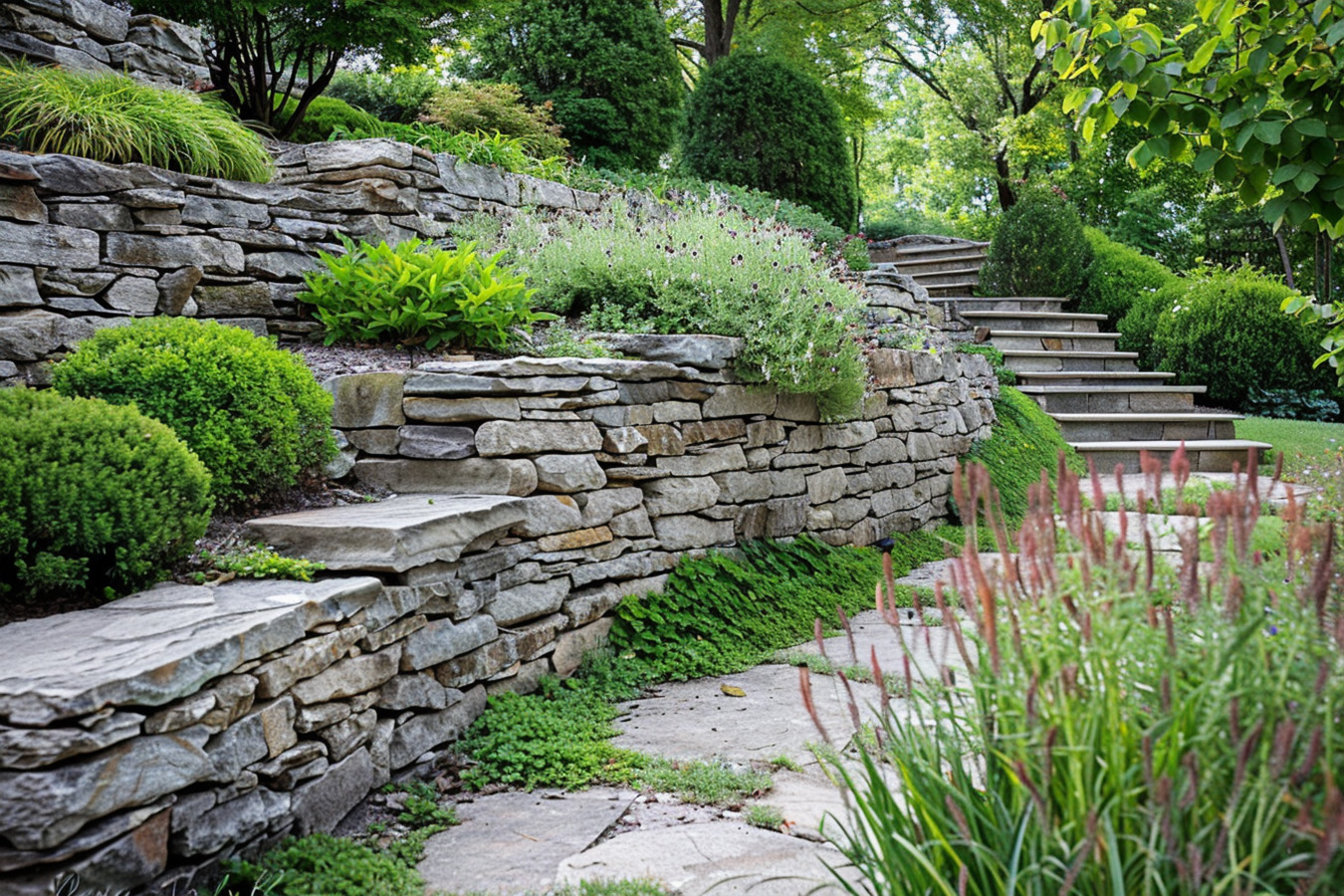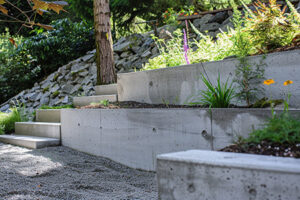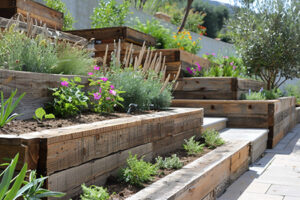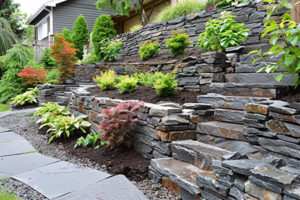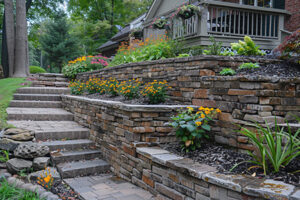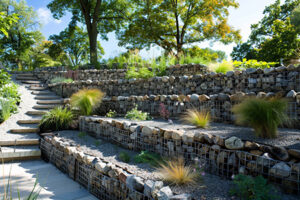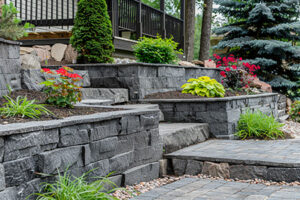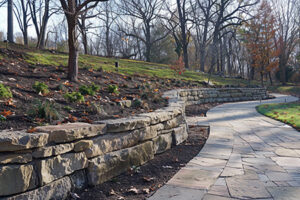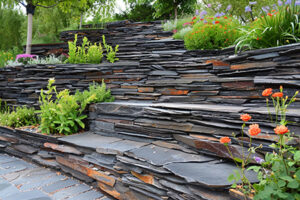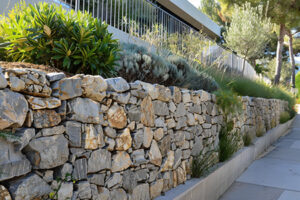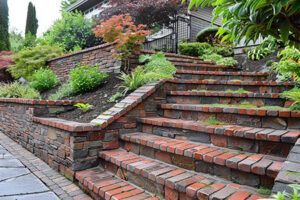The permanence of retaining walls is not just an anchor against shifting earth. It’s an architectural choice that defines the aesthetics and functionality of your outdoor space.
With an array of materials available, choosing the one that best suits your needs can be a landscape-scale decision.
From the strength of concrete to the organic allure of natural stone, each material construct offers a unique set of benefits and considerations that can elevate or detract from your project.
This guide dives deep into the material selection process, helping you build a retaining wall that stands the test of time and style.
Whether you’re a seasoned landscaper, a diligent homeowner, or a keen DIY enthusiast, crafting the perfect retaining wall begins with a proactive approach to material mastery.
Table of Contents
Understanding the Retaining Wall Material Mosaic
Retaining walls come in varied forms and serve specific purposes, be it for holding back soil on steep slopes, creating tiered planters, or simply defining the edges of a landscape.
The material you choose must align with these functions and harmonize with the overall design intent.
Here, we explore the most prominent materials for retaining walls, shedding light on their inherent traits and typical applications.
Concrete Retaining Walls: The Unyielding Foundation
Concrete’s reputation for strength and reliability has made it a staple in constructing many landscapes.
It offers a robust solution for retaining wall projects that demand structural integrity and long-lasting performance.
While initially heavy on the cost and labor for installation, its low maintenance requirements and versatility in design make it a solid investment.
Wood Retaining Walls: The Rustic Classic
Wood is a familiar favorite for those seeking a natural and warm aesthetic.
Whether you opt for treated timber or the timeless elegance of railway sleepers, wood grants a charming rustic appeal that is well-suited for short to medium-length walls and garden terraces.
However, its susceptibility to rot and insect infestations may be a cause for concern. It requires a diligent maintenance schedule to ensure durability.
Stone Retaining Walls: The Timeless Test of Nature
Using natural rock in retaining walls, quarried or fieldstone offers an enduring, natural beauty that seamlessly integrates with its environment.
Stonewalls are often the choice building material when blending into an existing landscape is key or when the goal is to create a feature wall that stands out with elegance.
They do require a skilled hand to build but are rewarded with minimal maintenance and longevity.
Brick Retaining Walls: The Artistic Divider
Bricks have been a building block of culture and architecture for centuries, and their appeal in retaining walls is no different.
Retaining wall blocks serve best in decorative applications and can provide a stately backdrop for garden settings and pathways.
While considered a relatively delicate material, careful placement and a sturdy foundation can render a brick wall just as enduring as its counterparts.
Gabion Retaining Walls: The Modern Mesh
Gabion walls are enclosures filled with large, durable rocks and wrapped in wire mesh.
Their industrial aesthetic finds a strong appeal in contemporary landscapes, and their design allows for flexibility in shape and texture.
Gabion walls excel as structural elements, providing excellent drainage properties and substantial strength for larger-scale projects.
Composite Retaining Walls: The Innovation Blend
Blending the best aspects of natural materials with the advantages of modern technology, composite materials offer a tailored solution for those who desire the look of wood or stone but demand higher resistance to the elements.
Composites are engineered for durability, often requiring little maintenance and simplifying construction with their uniform size and weight.
Weighing the Factors
The choice of retaining wall material shouldn’t be made in isolation. Various factors should be considered to ensure a selection that aligns with your specific needs and the confines of your project.
Retaining Wall Durability: The Wall’s Endurance Race
Assessing the material’s ability to withstand weathering, soil pressure, and moisture is paramount.
Robustness against these forces will determine the wall’s lifespan and the need for repairs or replacement.
Some materials, like concrete and certain composites, are engineered to resist environmental degradation, while others, like wood, may require more proactive care.
Retaining Wall Aesthetics: Crafting the Visual Narrative
The material’s appearance should complement the surrounding elements and reflect your design vision.
Each material has its own color range, texture, and pattern, so choose one that resonates with your landscape’s style.
Wood and stone’s naturalistic notes may appeal to gardeners and environmentalists, while concrete and gabion’s cleaner, utilitarian look suits modern and minimalist schemes.
Retaining Wall Cost Considerations: Balancing the Budget
The initial cost of materials and installation can vary significantly.
While wood and brick may seem more budget-friendly upfront, their longevity and potential maintenance might level the playing field against pricier but harder options like concrete.
A composite’s initial outlay is often higher, justified by its long-term savings in maintenance.
Retaining Wall Installation Complexity: Practicing Patience
The skill level and labor needed to install a particular material should match the available resources. For instance, stone and brick walls are more labor-intensive and require a level of craftsmanship, whereas concrete block walls may be more suited for those with a penchant for DIY.
Maintenance Requirements: Sustaining the Retaining Wall’s Life
Underestimating the need for maintenance can lead to costly repairs or replacements down the line. Assess the material’s susceptibility to decay, fading, or erosion, and be prepared to commit to a maintenance schedule that preserves the wall’s quality and appearance.
Applications and Best Material Matches
The purpose of a retaining wall dictates the material from which it should be made. Here’s a guide for matching material to the application:
Garden Retaining Walls: Wood or Stone
For terraces, garden borders, and planters, the warmth of wood or the organic charm of stone is ideal for blending with foliage and creating a harmonious backdrop for a naturalistic garden setting.
Structural Retaining Walls: Concrete or Gabion
Projects requiring substantial load-bearing capabilities and longevity should choose concrete’s strength or gabion structures’ industrial resilience.
Decorative Retaining Walls: Brick or Composite
Where the wall is primarily a visual element, such as in architectural features or to showcase a design aesthetic, the rich brick tradition or the tailored appearance of composite materials can complement the landscape.
Real-Life Revelations
The best advice often comes from those who’ve already taken the plunge. Case studies and examples can offer valuable insights into different material applications and the outcomes they yield.
Conclusion
In the grand design of your outdoor space, the retaining wall stands as a pivotal structure that marries purpose with presence.
The material you choose echoes beyond mere aesthetics, speaking of longevity, maintenance, and the sustainability of your design philosophy.
With this extensive guide as your compass, you’re ready to craft a retaining wall that not only holds ground but elevates the very earth it stands upon.
Remember, the perfect wall is not just about its material but the thoughtful process that leads up to its installation, unleashing its true potential as a centerpiece of your landscape.

